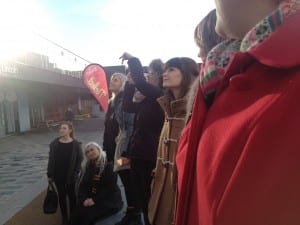On Wednesday, 2 of us from our group started to put the basic ideas together for our piece however, we found it difficult to formulate our ideas for our sites especially Pottersgate, even though we were passionate to have it in our piece. I discounted the idea of people marking their names in Pottersgate and came up with the proposal whereby the audience use chalk to mark the pavement with a feeling or a memory and then scrub it away as though wiping it from their memory; that way, they start the walk with a fresh mind and a new beginning. This idea was enhanced by an inspired thought from my lecturer who suggested we do something similar to Sand Mandala sculptures.
My notes on Sand Mandala sculptures:
- Kalachakra Mandala made out of coloured sand
- Created in 3 weeks
- This is a lesson about the impermanence of life
- Practitioners use mandala to visualise in meditation the steps along the path of enlightenment.
- Kalachakra means ‘wheels of time’.
Source: http://www.buddhanet.net/kalimage.htm
* The key things I picked out are in bold.
We have designed our performance so that we progress around 3 areas in the vicinity of the Cathedral which are Pottersgate, St Anne’s Well and the Cathedral garden. The idea of a pilgrimage came to mind however, we did not want our piece to be regarded as religious although this would be understandable with Lincoln Cathedral looming around us! so, I decided to ascertain the definition of the word ‘pilgrim’.
Oxford Dictionary definitions:
- A person who journeys to a sacred place for religious reasons.
- A person travelling to a place of particular personal interest.
- Chiefly literary a person regarded as journeying through life.
Source: http://www.oxforddictionaries.com/definition/english/pilgrim
* In bold are the key things I picked out.
Having looked at the definitions of the word pilgrim, I liked the idea of our piece being an adventure of personal interest whereby the performance is unfolding a story and that the meaning of the walk will be told at the end of it; it will be very similar to a learning walk.

